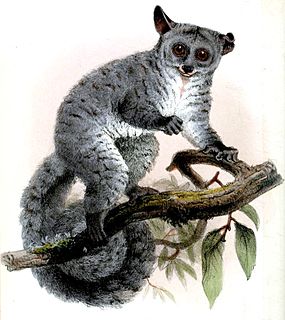
The greater galagos or thick-tailed bushbabies are everyday names for three species of strepsirrhine primates. They are classified in the genus Otolemur in the family Galagidae.

The Chironomidae comprise a family of nematoceran flies with a global distribution. They are closely related to the Ceratopogonidae, Simuliidae, and Thaumaleidae. Many species superficially resemble mosquitoes, but they lack the wing scales and elongated mouthparts of the Culicidae. An example of mosquito-resembling species is Tokunagayusurika akamusi.

The brown greater galago, also known as the large-eared greater galago or thick-tailed galago, is a nocturnal primate, the largest in the family of galagos. As opposed to smaller galago species it would climb, walk or run rather than leap.
Jentink's dormouse is a species of rodent in the family Gliridae. It is found in Cameroon, Ivory Coast, Ghana, Liberia, Nigeria, and Togo, and possibly Benin, Equatorial Guinea, and Sierra Leone. Its natural habitat is subtropical or tropical, moist lowland forests.

The Natal red rock hare or greater red rock hare is a species of mammal in the family Leporidae. It has a slightly grizzled, grayish brown head and reddish brown upperparts. The dense fur is thick and rougher than other rock hares. It is endemic to Africa, and found in southeastern provinces of South Africa, eastern Lesotho, Swaziland, and southern Mozambique. It is a herbivore, primarily feeding on grass. It breeds throughout the year, and one or two pups are usually born in the summer. It is rated as a species of least concern on the IUCN Red List of Endangered Species.

The red rock hares are the four species in the genus Pronolagus. They are African lagomorphs of the family Leporidae.

The silvery greater galago is a nocturnal primate from the galago family. It is usually found in Brachystegia woodland, from Angola to Tanzania, western Kenya and Rwanda.

Chironomus is a genus of nonbiting midges in the subfamily Chironominae of the bloodworm family, Chironomidae, containing several cryptic species that can only be distinguished by experts based on the characteristics of their giant chromosomes. The larvae of several species inhabit the profundal zone where they can reach relatively high densities. They use a combination of hemoglobin-like proteins and undulatory movements in their burrows to obtain oxygen in poorly oxygenated habitats.

The thickhead ground snake is a nonvenomous colubrid snake species, with no recognized subspecies, endemic to central Colombia.
Chironomus riparius, also known as Chironomus thummi and commonly known as the harlequin fly, is a species of non-biting midge. Their larvae are known by the common name of blood worm due to their red colouration. It is common in both North America and Europe. The species was described in 1804 by Johann Wilhelm Meigen. C. riparius has been used extensively as a model for genome structure analysis in insects and is also used in toxicology tests and functional developmental genetic studies. Both their adult and larval forms have been implicated as disease vectors but are also an important part of freshwater food chains.
Gammaentomopoxvirus is a genus of viruses, in the family Poxviridae, in the subfamily Entomopoxvirinae. Lepidoptera and orthoptera insects serve as natural hosts. There are currently six species in this genus including the type species Chironomus luridus entomopoxvirus.

Chironomus zealandicus, commonly known as the New Zealand midge, common midge, or non-biting midge, is an insect of the Chironomidae family. The worm like larvae known to fisherman and a common name as blood worm due to its red color and elongated blood gills.
Chironomus ochreatus is a species in the family Chironomidae ("midges"), in the order Diptera ("flies").
Chironomus tuberculatus is a species of midge in the family Chironomidae.
Chironomus atrella is a species of midge in the family Chironomidae.
Chironomus atroviridis is a species of midge in the family Chironomidae.
Chironomus staegeri is a species of midge in the family Chironomidae. It is found in Europe.
Chironomus whitseli is a species of midge in the family Chironomidae.
Chironomus annularius is a species of non-biting midge in the family Chironomidae. It is usually found in regions with bodies of fresh water but can be found in almost every environment. It tends to form "hotspots" around specific areas. The species is distinguished by the size of its chromosomes and the lack of a proboscis.







